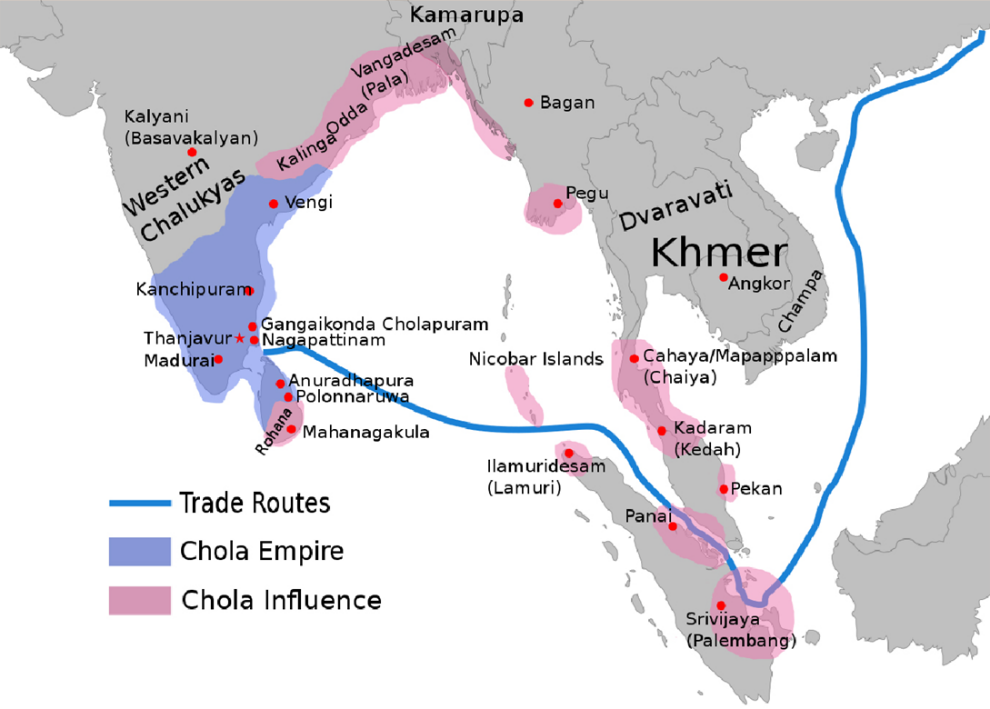PREVIOUS
Rajendra Chola’s Gangetic expedition
August 1 , 2025
138 days
901
0
- Rajendra Chola - I’s mighty army traversed vast swathes of eastern and northern India in the 11th century CE.
- It was the popular belief that Rajendra Chola personally marched towards the Gangetic plains.
- But inscriptions on the Tiruvalangadu copper plates reveal that one of the ablest generals of the king had commanded the military expedition towards the Ganges.
- The Chola monarch had stayed back on the banks of the Godavari.
- The historical works such as The Cholas by K.A. Nilakanta Sastri, Pirkaala Sozhar Sarithiram (History of Later Cholas) by T.V. Sadasiva Pandarathar, and The Palas of Bengal by R.D. Banerji reveals that.
- These accounts reveal the Chola forces defeated kingdoms in the eastern Deccan, coastal Odisha, and eventually clashed with the Pala dynasty in Bengal.
- The actual campaign began not from the Chola’s capital in the South, but from the northeast of Venginadu that spread across the Godavari and Krishna rivers.
- Venginadu, at that time, was ruled by kings (Eastern Chalukyas or Chalukyas of Vengi) loyal to the Cholas.
- Due to Vengi’s close ties with the Cholas, and since all the regions to its south were already under Rajendra Chola’s empire, the expedition began north of Vengi, with the first conquest in that campaign being Chakrakottam.
- Chakrakottam is situated eight miles from Rajapura, on the southern bank of the Indravati River.
- In modern times, the place is known as Chitrakootam (Bastar region in present-day Chhattisgarh).
- After the fall of Chakrakottam, the Chola army marched towards the green fields of ‘Masuna Desam’ or ‘Masuni Desam’ under the control of brave rulers of the Chindaka family.
- The Chindaka family identified themselves as belonging to the Naga lineage.
- Nilakanta Sastri, while citing a Tamil Prasasti, says the region of Maduramandalam, Namanaikkonam and Panchappalli, all fell under the ‘Masuni Desam’.
- Maduramandalam was destroyed in a trice by the Chola army.
- Namanaikkonam and Panchappalli were also conquered by Rajendra’s commander.
- Following that, the Chola commander marched further northeast, defeated Indraratha at Adinagara, and captured the regions of Odda (Odisha).
- His campaign took a westward turn with the capture of the Kosala kingdom.
- The region of Kosala referred to here is Dakshina (southern) Kosala, also known as Mahakosala.
- Having consolidated control over central-eastern India, the next target was Dandabhukti to the east, ruled by Dharmapala.
- Dandabhukti comprised the southern and southwestern parts of the Midnapore district in Bengal.
- Therefore, it likely stretched along both banks of the Subarnarekha River.
- From there, the Chola forces advanced towards Bengal.
- After defeating Dharmapala, Rajendra’s army marched towards Dakshinaradha (Takkana Ladam in Tamil), ruled by Ranasura.
- ‘Radha’ (also spelt as Ratta or Lada) was the ancient name of a part of Bengal, which was bounded on the north by the Ganges.
- Dakshinaradha refers to the area comprising today’s Hooghly and Howrah districts in Bengal, while Uttararadha (Uttara Ladam in Tamil) refers to the regions comprising Murshidabad and Birbhum districts.
- With southern Bengal subdued, the commander passed eastwards, crossed the Ganges, and reached Vangala Desam (Eastern Bengal), which was then ruled by Govindachandra.
- Following the conquest of Eastern Bengal, Rajendra Chola’s army turned westward and defeated Mahipala.
- The commander reached the Ganges, fetched water from the river, and brought it to his sovereign lord, Rajendra.
- The commander the King met on the banks of the Godavari during the army’s retreat.
- Though the fetching of the Ganges water was perhaps part of the original objective.
- But the true motive was undoubtedly an exhibition of the Chola empire’s power and a demonstration of its strength to the rulers of northern India.
- Rajendra then returned to his kingdom with his victorious general.
- During his return journey, he visited various temples and made offerings, as mentioned in several inscriptions.
- One such inscription was found in Thriloki (modern-day Thirulogi near Thiruppanandal in the Thanjavur district), located about ten miles southeast of Gangaikonda Cholapuram.
- A fragmentary record engraved in Tiruloki makes an interesting reference to the incident of the king worshipping the sacred feet of the Lord at this village.
- That is only about 10 miles from Gangaikonda Cholapuram.
- The ancient name of this place was given as Trailokyamahadevi-chaturvedimangalam.
- The aim of the expedition was not merely to bring down the water of the Ganges to the Chola capital.
- But to do so after establishing a right of way across territories outside the empire by a strong show of force.
- This becomes clear from the statement that at the end of the expedition, Rajendra erected a ‘liquid pillar of victory’ (jalamayam jayastambham) in his capital with the waters of the Ganges, in the form of the tank Cholagangam.
- The invasion of the Chola king did not change the political divisions of the country, but it left one permanent mark in the shape of a body of settlers.

Leave a Reply
Your Comment is awaiting moderation.


